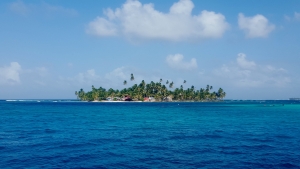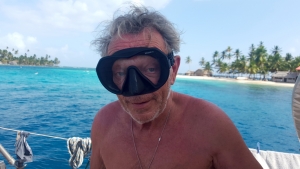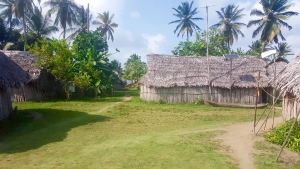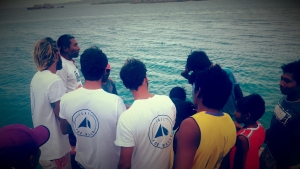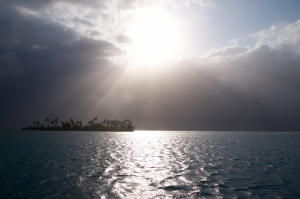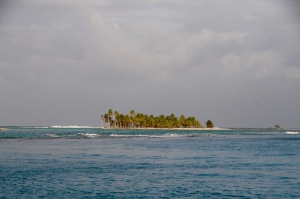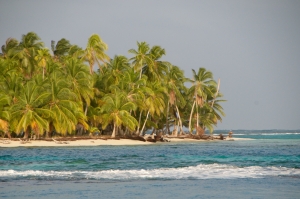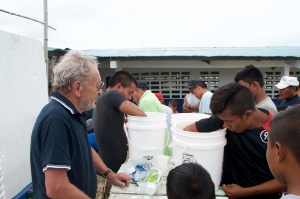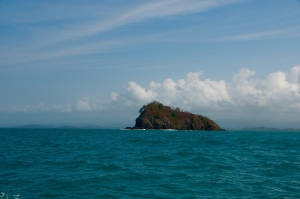
San Blas, the Kuna’s territory
After 6 days at sea since our departure from Jacmel in Haiti, we finally arrived in the large bay of Colon, mandatory stop for the Panama’s canal. We stayed around 5 days there to prepare our mission in the San Blas and organise our crossing of the canal for mid-February. You can believe us on that, it’s not an easy thing. Firstly, because the only marina of the bay is on the other side of the city and that we need 1h of cab to reach it. Secondly, because we have to run between 4 different offices to register both the boat and the crew entrance on the territory on one side, and register then pay for the canal crossing but only once an inspector checked the exact length of the Williwaw on the other. Thankfully, we found a great driver, who knows exactly where to go and who truly helped us with all this.
Once the formalities are done and the buying of 75 buckets secured, we set sail for around 15h to reach the San Blas. Jan-Michel, a Brazilian native and adopted French, is our local contact and quickly introduce us to Plas, a Kuna who is in charge of a hotel and restaurant on his island (Tortuga) and who has a strong interest in the project. Plas agrees to guide us to the islands that most required the filters and to provide us with unlimited lobsters!
The San Blas is a group of not less than 365 islands. Nearly one for each day of the year! There is around 50 000 Kunas on those islands, divided in 52 communities. The San Blas were really isolated 6 years ago. With the construction of a road coming from Panama City, the archipelago has welcomed the tourist industry and money that comes with it. Before that, the Kunas didn’t have a word for ‘money’ in their native language (the Kuna) and were only relying on barter with coconuts, bananas or fish. With the tourist industry, development has reached the islands located close to the road. One may find solar panels and satellite dishes, which provide a new comfort to the population. However, access to clean and drinkable water remains a problem. The village-islands are often linked to a river via pipes and they store clean water before drinking it. Sadly, this water is neither controlled nor treated. People from other islands come to collect water with large cans on the ones which are linked to the river.
We needed to act! Thanks to Plas, we quickly chose 5 islands that were going to benefit from our filters. 4 of them were quite small and we dropped off 4 to 6 filters on each. The fifth one, Atchutupu, the island where Plas grew up, is made of 350 houses for around 3000 people. It is quite far from the road and does not benefit from the tourist industry as the first islands. We have distributed 53 filters, our biggest distribution since the start of the journey. To do so, we first met the chiefs of the village in the council’s hut. The Sahilas (village’s chiefs) were seated in hammocks in this large hut and welcomed us with large smiles. We gave them explanations about the project, the dangers of unclean water and the benefits of the filters we use. They were interested and enthusiastic and helped us to organise the drop off of the 53 filters.
Our priority was of course classrooms of the school and the medical centre. As usual, we wanted to ensure that the maximum of persons had access to filtrated water. The following morning, we came back to the island with our equipment to start explanations on the issues related to clean water. Romain was in charge and explained to the group the necessity of water, filtration and maintenance of the filters. After a first demonstration, everybody started to practice and built the 53 kits. The Kuna showed us their organisation skills by dividing the tasks to form various building zones. They were our best students since the beginning of our adventure. All this work was followed by relaxation and we were invited to enjoy a banana juice with coconuts, classics of the San Blas, before a guided tour of the island. A privilege moment of exchange and mutual sharing, albeit brief. It is true that we would have loved to share a meal or a ceremony with this community, but we realised it will take months to gain their truth.
The Kuna tradition is indeed quite strict on the relations with non-Kunas. The community does not accept (or in very few circumstances) weddings between Kunas and foreigners. Is it because exchanges are still very superficial? We were sometimes surprised by the lack of integration we faced. We believe it is due to a strong traditional culture. The Kunas try to resist to development and globalisation to safeguard their traditions, but for how long? We have seen all these solar panels, satellites dishes, flat screen tvs and phone, proof that it is now difficult to avoid the civilised world. Will the Kunas open their doors to this change once they will benefit from it?
The trip back to Colon was done quickly, even if we made stops every night, as navigation by night is too risky in the corals reefs of the San Blas. It was then time to close the Atlantic side of this journey and start the Pacific side by crossing the mythic Panama Canal.
After few days in the marina of the Atlantic side, we were ready for our trip in the world’s largest ocean. Plas joined us, as we needed to be at least 5 on board to manoeuvre the boat in the locks. Our planning: 6 locks, the crossing of 2 artificial lakes and around 24h in freshwater.
Saturday 27th of February, in the morning (happy birthday Thomas), we left the waiting zone of the canal where the first pilot has joined us to cross the first 3 locks. We left at around 6pm with ‘Lady Amber’, a pretty two-mats which crossed the 3 gates with us. The experience is incredible, the locks’ doors are more than 15 meters high and we feel so small in there. After 2h of elevation, we arrived in the artificial lake of Gatun, the largest freshwater reserve of the country, where we stayed for the night.
Sunday 28th of February at 8 am, the second pilot joined us to cross the canal and the 3 locks to reach the Pacific ocean. The crossing of the Gatun’s lake took 4h and we saw several seas’ giants: tankers, ferries… Once again, we felt so small in this world made for giants. Finally, early afternoon, we crossed the 3 last locks and arrived in the Pacific Ocean, an ocean full of hopes where we are going to spend more than a year. We are very excited to finally be there. Who know what we will face here? To discover it, we need to go and have a try.
Our next adventures in Nicaragua, in the Chinandega’s region, are likely to be eventful.


